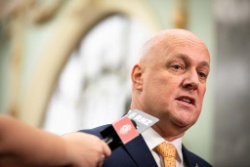The kerfuffle over Coromandel is not about MMP. Rather, it's about first-past-the-post (FPP) and its retention in the MMP electorate vote.
In the 1992 indicative referendum, only 200,000 people were motivated to go to the ballot in support of the FPP (or FR "front runner" as Brian Easton more accurately calls it in his The Whimpering of the State) electoral system. A population acclimatised to FPP resoundingly rejected FPP either by voting against it or by not voting at all.
Unfortunately, the 1993 MMP legislation only rid us of one of the terrible anomalies of FPP; namely its tendency to select far too many MPs from one or both of the "major" parties while leaving the other parties grossly underrepresented in Parliament. In 1978, the party polling second with 37% of the vote gained over 55% of the seats. In FPP Britain and Canada in the 1990s, the present governments came to power with huge "landslide majorities" while gaining only a minority of votes. We can call this anomaly of distorted representation the 'macro-anomaly' of FPP.
(We might note that, under FPP, if all electorates are homogeneous, then one party will win every seat, no matter how close the vote. FPP only seemed to work because people from different social strata lived in different electorates. It was, more than we realised, a relic of the British class system. The drawing of electoral boundaries became a critical determinant of the overall election result. Wellington, in 1978, was a classical gerrymander.)
The other anomaly - the 'micro-anomaly' relates individual electorates. Ultimately it was the micro-anomaly of FPP voting that caused the macro-problem. Few MPs gain a majority of votes in their electorates. Some, with just one-third of the support of their electorate, were still "elected" with published "majorities". Of course such MPs never had a majority, only a margin over the second-placed candidate.
The problem remains however that electorate MPs can still be elected with 25% or less of the vote if there are 5 or more candidates. A recent poll in the Waiariki electorate showed that the Labour candidate is leading with just 27% support. If reflected in the final vote, he will win with a huge minority! (Don't write off Tuariki Delamere, who's on 25%.)
The result of this problem is that supporters of smaller parties were more or less obliged to vote "tactically" for one of the major parties. Under FPP, the electorate vote, while nominally a personal electorate vote, was in reality a party vote. People forever moaned, wishing for the opportunity to have a personal vote separate from their party vote. They got their wish in the 1993 referendum.
Unfortunately, we retained the electorate voting system that does note require candidates to have majorities. Most of our electorate MPs "came through the middle", benefiting from the spread of votes for other candidates. Electorate elections remain a lottery. Winning depends on the split of support for other candidates. Only tactical voting can get around the phenomenon of the "split vote". In the bad old days, as a matter of course we tactically voted against the candidate representing the party we hated the most by voting for the candidate best placed to defeat him or her.
Because of our retention of FPP in electorates, such tactical voting persists, but only in a few strategic electorates. It is FPP tactical voting - not MMP tactical voting - to vote against the candidate you least want to win. (MMP tactical voting is about voting for a second-choice party to get it over the 5% hurdle so it can act as a coalition partner of one's first choice party.)
The micro-anomaly of FPP can be and has been dealt with in many ways in the past. Australia deals with it by using preferential voting. French elections run on a two-ballot system, with the second ballot being a head-to-head run-off between the two leading candidates in each electorate.
The Labour and National Parties, when choosing their leaders, have a multiple balloting system. In practice however, in New Zealand they run only one ballot. They cut to the chase by going straight to the final ballot, which is a run-off between the two leading candidates. Also-ran candidates withdraw before the ballot is taken, thereby enabling a multiple-ballot election to be, in practice, just one ballot.
----------------------
New Zealand moved to the French two-ballot system in 1908. The change, while successfully electing candidates with true majorities, was unfortunately undertaken for cynical party political reasons. Joseph Ward believed that the two-ballot system would help him to retain power. While indeed the Liberals did hang on for another term, an analysis of the first ballots showed that they would have hung on regardless.
The interesting election was that of 1911. A new party, a precursor of Labour, gained the "balance of power". Ward hung on with a minority government for a few months, and then resigned as Prime Minister in favour of Thomas Mackenzie. The Mackenzie minority government fell at the end of 1912, when Massey's Reform Party was able to gain the confidence of Parliament.
The crucial "turncoat" was Gordon Coates, the newly elected Independent Liberal MP for Kaipara. Ward stood a candidate against Coates in the first ballot of the 1911 election. But, after Ward's candidate was eliminated, Liberal voters supported Coates in the second ballot. A year later, Coates did a "deal" with Massey in order to help form a stable government. (Coates, unlike Winston Churchill, only switched parties once!) Coates eventually became Massey's successor as Prime Minister (1925-28). Later, as Minister of Finance (1933-35) and leader of the junior partner in the 1931-35 coalition government, Coates did more than any other politician to pull New Zealand out of the Great Depression.
Looking at Coates from a historical perspective, he could never be called a disloyal politician. He took his chance to both make his name and to create a government while sticking to the principles of pragmatic kiwi-style liberalism.
Massey abolished the two-ballot system, on partisan grounds, in 1913. Massey believed he could retain power for longer by enabling his opposition - Liberal and Labour - to remain divided. Massey, like Holyoake in the 1960s, retained power for 12 years, courtesy of single-ballot FPP voting.
We should learn from the 1908-13 episode. Decisions about electoral systems need to be made in a bipartisan manner with the long term in mind.
Unlike the electoral changes at the beginning of this century, the shift to MMP was not an act of political expediency. Rather, it represented a permanent change to our political landscape, ratified by an exhaustive process which started with the 1986 Royal Commission.
The introduction of MMP after 1993 should be compared to the 1893 legislation to give votes to women. Like the shift to MMP, but unlike the shift to 2-ballot elections in 1908, the enfranchisement of women was opposed by the government of the day. It was controversial, but non-partisan.
We would be embarrassed to read our own history if we had abolished female voting in say 1900. We should be embarrassed at the ease in which Massey was able to manipulate the electoral system to serve his ends.
----------------------
There are at least four ways of simulating a multiple ballot electorate election under MMP.
The most obvious is to adopt Australian-style preferential voting. In Australia, there is a coalition government and the coalition parties always stand candidates against each other. They don't have any of our angst, however, because most people who vote for either partner vote for the other partner as their second preference. Under preferential voting, most Labour and Alliance voters in Coromandel would place Jeanette Fitzsimons ahead of Murray Maclean in their order of preferences.
The second method would be to adopt a new kind of transferable voting whereby 'also-ran' candidates would have the option to transfer all their votes to another candidate. (To use racing parlance, this is the "off-course substitute" model which applies to late scratchings.) To gain public acceptance, candidates who withdraw on election night would have to have stated before polling who their substitute candidates would be.
These two methods would both require legislation. Yet major legislative changes to the electoral system should be infrequent and well considered, as we should have learned from the Ward-Massey episode. There are two other ways of dealing with the FPP micro-anomaly that MMP has inherited.
The first of these is for allied parties to get together and to run a single candidate to represent them all. (City Vision did this in the 1998 Auckland City Council elections, and there was no cry about anti-democratic deals. The result of this pragmatism is that Auckland now has a left-leaning council). That is of course the sensible conclusion that National, United and Act have reached re Wellington Central, Ohariu, Tauranga and Coromandel.
To not stand a candidate against your political ally is a forgotten part of New Zealand's political culture. The First Labour Government was in fact a coalition between Labour, Ratana and Nelson's Harry Attmore. Labour did not stand candidates against Ratana or Attmore; rather they formed an accommodation just as National does today with Peter Dunne.
In those days, National formed three electoral accommodations, with the Independent MPs of Egmont, Mataura and in seat that has evolved into Peter Dunne's Ohariu seat.
The alternative to not standing a candidate is the strategy that Labour is adopting, and that Jim Bolger adopted with respect to Wellington Central in 1996. The strategy is to suggest that voters do not vote for their party's candidate where that candidate obviously will not win. This strategy is unsound in that it gives the impression that leaders are disloyal to their candidates. It also suffers from the fact that many voters don't take the hint. New Zealand voters sometimes react perversely. (Indeed I understand that some people planning to vote NZ First next month will do so because of the mayhem his presence causes. We vote Winston Peters as a way of punishing the other politicians. It works.)
The failure of Labour and the Alliance to have thought through the issue of making electoral accommodations with stronger candidates of allied parties could very well see the return of the Shipley government. Shipley and Prebble both understand the electoral system better than Clark and Anderton. And they understand the psychology of New Zealand voters better.
Just as stupid as the left's failure to unite over Coromandel is the fact that a Labour candidate is campaigning against Jim Anderton in Wigram. In 1993 the left parties allowed the right to win by not running united left candidates in marginal electorates. A split electorate vote for the left in Wigram this year could lead to a National victory with as little as 30% of the electorate vote. If, at the same time, the party votes read (say) 42% Labour, 40% National, 4.9% Alliance, 4.1% Greens, 4% Act, 2% NZ First and 3% others, then National, Act and United would be able to form a government despite being outvoted.
Let's adopt de facto preferential electorate voting in 2002. Then we'll finally be rid of FPP. It's up to the parties themselves to manage the process, in their own interest as well as in the public interest. MMP will be seen to be working when we see politicians cooperating across party lines in order to further the interests of their constituents.
ends



 Gordon Campbell: On The Coalition’s Awful, Not Good, Very Bad Poll Results
Gordon Campbell: On The Coalition’s Awful, Not Good, Very Bad Poll Results Ian Powell: Policy Vacuum Enables For-profit Corporate General Practice Ownership By Stealth
Ian Powell: Policy Vacuum Enables For-profit Corporate General Practice Ownership By Stealth Gordon Campbell: On Iran Killing Its Rappers, And Searching For The Invisible Dr. Reti
Gordon Campbell: On Iran Killing Its Rappers, And Searching For The Invisible Dr. Reti Peter Dunne: MPs Unusually Quiet On Pay Rise
Peter Dunne: MPs Unusually Quiet On Pay Rise Ian Powell: Cuba And New Zealand: A Relationship Worthy Of Strengthening
Ian Powell: Cuba And New Zealand: A Relationship Worthy Of Strengthening Gordon Campbell: On bird flu, AUKUS entry fees and Cindy Lee
Gordon Campbell: On bird flu, AUKUS entry fees and Cindy Lee